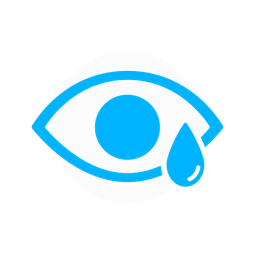Dry eye syndrome can cause a range of frustrating symptoms that make everyday activities a pain. Yes, dry eye syndrome can cause blurred vision due to issues with the eye’s tear film, which plays a crucial role in maintaining clarity and focus.
If you’re dealing with recurring blurry vision, it’s important to consider that it might not solely be a refractive error or an eye disease. Your optometrist can examine your symptoms and determine the proper cause. Once we know that, we can help you take steps toward healthier eyes.
What Is Dry Eye Syndrome?
Dry eye syndrome is a chronic condition caused by an issue with the eye’s tear film. The tear film is composed of 3 layers, oil, water, and mucus. It’s essential for keeping the eyes moist, comfortable, and, importantly, providing clear vision. There are 2 main causes of dry eyes:
- Evaporative dry eye occurs when the oil layer of the tear film is insufficient, leading to premature tear evaporation. This is often due to meibomian gland dysfunction (MGD).
- Aqueous deficient dry eye happens when the eyes fail to produce enough watery tears to stay lubricated.
Both types of dry eye can affect the stability of the tear film, potentially resulting in discomfort and blurred vision.
How Does Dry Eye Cause Blurred Vision?
The tear film covering your eyes acts as the first layer of light refraction, meaning it’s vital for sharp vision. When the tear film is unstable—due to either evaporative or aqueous deficient dry eye—the light entering your eyes may scatter, leading to distortion and blurred vision. This type of vision issue differs from other causes, like refractive errors, because it fluctuates, often improving when you blink or apply artificial tears.
Furthermore, prolonged dryness can damage your eye’s surface, which may worsen the blurriness.
Dry Eye Symptoms & Signs to Watch For
Dry eye syndrome doesn’t always manifest as a single clear symptom. Instead, it often involves a combination of signs, such as:
- Stinging, burning, or gritty sensations in the eyes
- Redness
- Sensitivity to light
- Difficulty wearing contact lenses
- Eye fatigue or strain, especially after screen use
- A feeling of something “in your eye”
- Trouble seeing clearly in low-light conditions, such as at night
Blurred vision often accompanies these symptoms, particularly if the condition is left untreated.
If your symptoms disrupt daily activities such as reading, driving, or working on a computer, it may be time to contact an eye doctor. Untreated symptoms can lead to more severe complications, including damage to the corneal surface.

How Do Optometrists Diagnose Dry Eye Syndrome?
When you visit an eye doctor for dry eye syndrome, they’ll conduct specific tests to both diagnose the condition and assess how it impacts your vision. These include:
- Tear Breakup Time (TBUT): A test to measure how quickly your tears evaporate.
- Schirmer’s Test: Conducted to determine if your eyes produce enough tears.
- Corneal Staining: A dye test that highlights any damage or dryness on the eye’s surface.
- Meibography: Used to check for blockages in the oil-producing glands, primarily for evaporative dry eye.
The insights gained through these tests can help create a personalized treatment plan to relieve symptoms and improve your vision quality.
These tests are often part of a larger comprehensive eye exam. Serious eye diseases, such as cataracts or age-related macular degeneration, can also cause blurred vision. Regular eye exams allow optometrists to monitor these conditions and determine what exactly is causing your vision problems.
Dry Eye Syndrome Treatments
Relieving dry eye symptoms often requires a combination of treatments, tailored to the type of dry eye syndrome you’re experiencing:
- Artificial Tears: Over-the-counter lubricating drops can temporarily alleviate dryness and blurred vision. Opt for preservative-free formulations for long-term use.
- Medications: Prescription eye drops can reduce inflammation or boost healthy tear production to provide more substantial relief.
Helpful Tips for Managing Dry Eyes
Beyond treatments prescribed by your eye doctor, consider these simple ways to reduce dry eye symptoms and maintain clearer vision:
- Use a humidifier in your workspace or bedroom to maintain moisture in the air.
- Take regular breaks during screen time to reduce eye strain and promote blinking.
- Include foods rich in Omega-3 fatty acids and Vitamin A in your diet to support eye health.
- Follow proper contact lens hygiene and wearing schedules as directed by your optometrist.
Clear Vision, Healthy Eyes
Blurred vision due to dry eye syndrome can affect daily life and productivity, but it doesn’t have to be a permanent issue. With the right diagnosis and a customized treatment plan, your eyes can regain comfort and clarity. But if treating your dry eye doesn’t correct your blurry vision, See Eye Clinic can help uncover and treat the real issue.
Schedule an appointment today and discover how our experienced team can help you achieve clear, healthy vision. We’re dedicated to supporting your eye care needs—because your vision deserves nothing less.




















